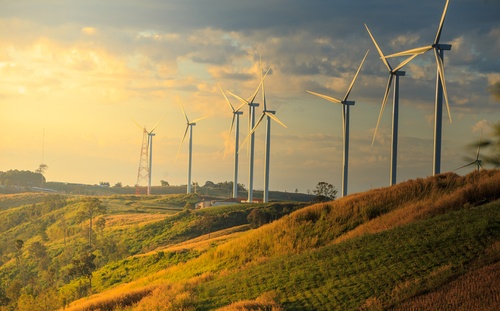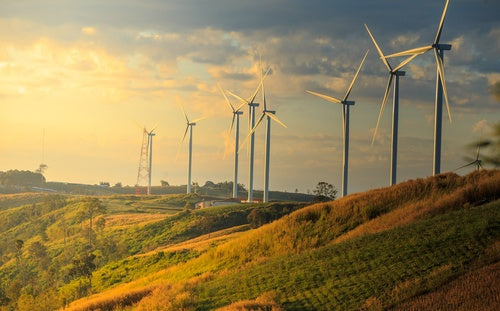Buildings consume more than 70% of the US electricity supply, which is why energy efficiency measures have such high potential to reduce the environmental impact of modern cities. Traditionally, electricity is generated in power plants and then delivered to buildings through power lines and transformers. However, modern generation technologies, such as photovoltaic panels and natural gas microturbines, allow electricity to be produced at the point of use.
There are a wide variety of electricity generation methods, each with advantages and limitations. Generation technologies can be classified in several ways:
-
Energy source used to produce electricity
-
Renewable or non-renewable
-
Production of greenhouse gas emissions
-
Dispatchable or variable
Improve your building's energy performance.
Energy sources used in the production of electricity
A basic principle of physics is that energy cannot be created or destroyed, it simply changes form. As electricity is a form of energy, generation systems can only produce it by consuming another form. The following are some of the most common energy sources:
-
Chemical energy in fossil fuels: Their combustion releases heat, which can be used to drive turbines and generators, producing electricity.
-
Kinetic and potential energy in water: Water can be stored in a reservoir and then used to drive a turbine and generator. There are also hydroelectric plant projects that do not use a reservoir and instead extract energy from a moving river. There are also experimental technologies that produce electricity from waves or tides.
-
Kinetic energy from wind: Wind turbines produce rotational movement, driving a generator and producing electricity.
-
Chemical energy in organic waste (biomass): Organic waste can be transformed into various types of biofuels. They can be used for turbines in the same way as fossil fuels.
-
Solar radiation: Photovoltaic panels can produce electricity from the energy contained in sunlight. Unlike previous examples, solar panels have no moving parts and their maintenance is very simple.
-
Underground heat (geothermal): By drilling in a suitable location, it is possible to drive a turbine and generator with underground heat.
-
Nuclear energy: Atoms of radioactive elements such as uranium and plutonium can be split to release large amounts of heat, which is then used to power a steam turbine.
The price of electricity depends heavily on the resource used to produce it. Also note that the availability of energy sources changes by region and electricity costs increase if a resource has to be transported from remote locations.
Renewable and non-renewable electricity sources
The media often uses the concept of renewable generation to describe clean energy sources, but there is an important difference between the two terms. Of course, many energy sources are clean and renewable.
An energy source is called renewable if the current consumption rate does not limit future availability. Solar generation is renewable, for example, since adding more photovoltaic panels to buildings does not limit the future availability of sunlight.
-
Even if all the roofs in the world were covered with solar panels, the amount of solar radiation reaching the planet would remain constant.
-
Wind energy is also renewable, as natural wind patterns continue to exist with or without wind turbines.
Non-renewable energy sources are finite and using more of them today leaves less available for the future. Fossil fuels are the best-known example, as they take millions of years to form and cannot be replenished quickly enough to keep up with human consumption.
Greenhouse gas emissions from electricity generation
Many renewable sources are clean, but this is not always the case. For example, biomass energy is considered renewable because it uses biofuels processed from organic waste. However, the combustion of these fuels releases greenhouse gases, even when their source is renewable.
All generation systems have an environmental impact due to the manufacturing of equipment and the construction of power plants. However, polluting sources continue to release emissions during operation, while clean sources produce little or no emissions after construction.
Electricity sources that produce emissions also vary in terms of their carbon footprint. For example, both natural gas and coal produce emissions, but emissions per kilowatt-hour are more than double when coal is used.
Dispatchable and Variable Electricity Generation
The concept of dispatchable generation is the least known among the general public, but for utilities it is vital to maintain a reliable power supply. A dispatchable power source that can be trusted to deliver electricity on demand. This excludes solar and wind energy, as they use production factors that cannot be controlled. On the other hand, hydroelectric plants can store water to provide electricity at any time and are considered dispatchable.

If an electrical grid relies too much on variable energy sources, electricity supply can become unstable because output constantly fluctuates. Thus, utility companies typically rely on a combination of sources: wind and solar power are variable but offer a very low cost per kilowatt-hour, while dispatchable sources are used to balance generation and consumption.
An innovative concept is the use of large-scale energy storage to complement solar and wind energy, transforming them into dispatchable sources. Although the cost of batteries is still a barrier, it is decreasing rapidly and the concept has already been successfully implemented in places with expensive electricity.
Implementation of electricity generation systems in buildings
Because each property is unique, the first step to implementing on-site generation is to undergo an inspection by a qualified energy consultant. For example, a roof that is constantly covered by shadows from a neighboring building is not suitable for solar energy. Ideally, on-site generation should be complemented with energy efficiency – completely powering a building with on-site generation is easier and less expensive when electricity consumption is optimized first.

